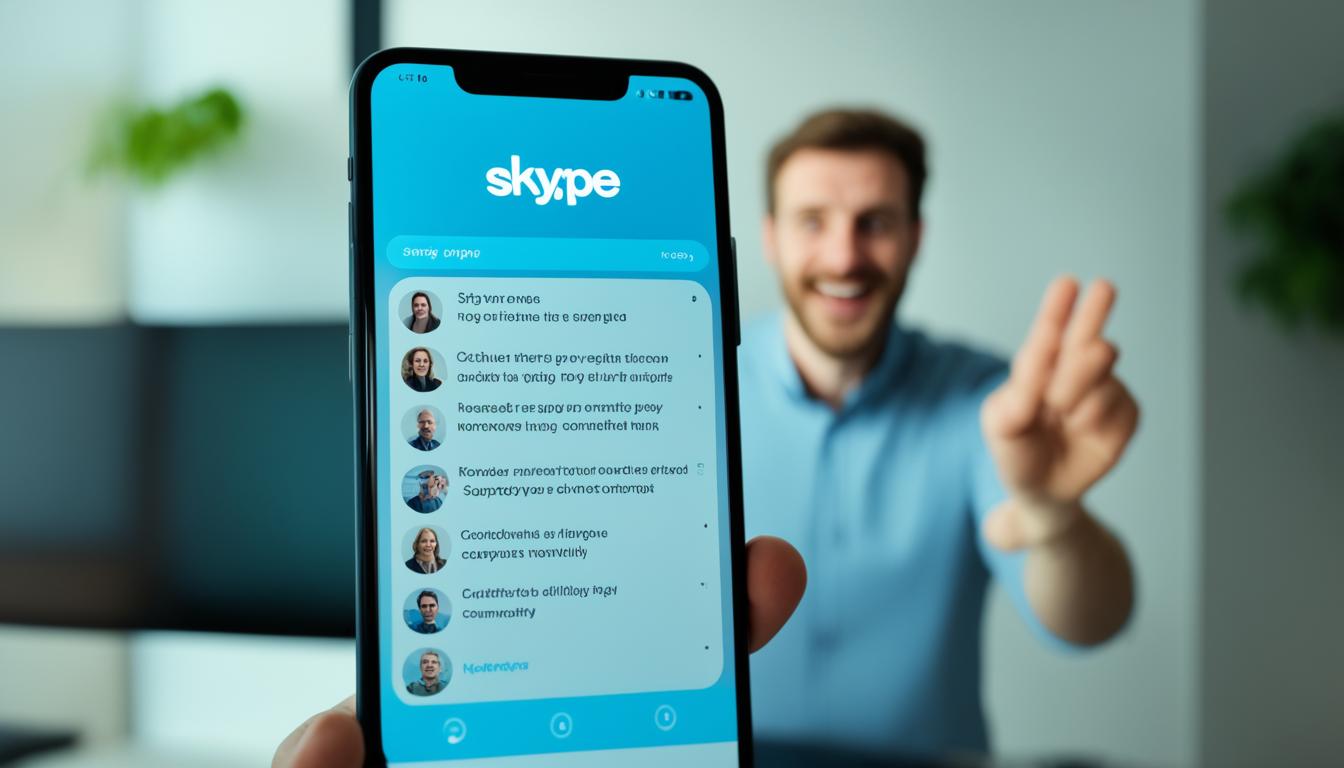Have you ever thought about how much our ability to communicate relies on our ability to hear? The voice of a loved one, the laughter of friends, and the conversations that are the basis of our relationships are all crucial. However, for those who have hearing difficulties, participating in and fully enjoying these interactions can be challenging. We believe that a person’s ability to communicate should not be limited by their hearing, and this is the aim that Skype seeks to achieve.
Skype, the popular communication platform, offers a remarkable feature that can revolutionize the way hearing impaired individuals connect with others. With Skype’s speech-to-text feature, real-time transcription during voice and video calls becomes a reality. This powerful tool allows those with hearing impairments to read what others are saying, enabling them to fully understand and actively engage in conversations.
Imagine the joy of being able to converse effortlessly, without straining to catch every word or feeling left out of the conversation. Skype’s speech-to-text feature opens up a world of possibilities, empowering those with hearing impairments to communicate on equal footing with others.
Whether it’s a heartwarming conversation with a loved one or a productive meeting at work, Skype’s speech-to-text feature ensures that every word is accessible. It’s not just a tool; it’s a gateway to a more inclusive and connected world.
In this article, we’ll dive deeper into the impact of Skype’s speech-to-text feature for hearing impaired users. We’ll also explore other communication tools and technologies that can make a difference in the lives of those with hearing impairments. So join us on this journey as we explore the possibilities and celebrate the power of communication for all.
Key Takeaways:
- Skype offers a speech-to-text feature that provides real-time transcription during voice and video calls.
- This feature enhances communication for those with hearing impairments by making conversations accessible through text.
- Skype’s speech-to-text feature promotes inclusivity and ensures that everyone can actively participate in conversations.
- Communication barriers can be overcome with the help of technologies like speech-to-text apps and assistive devices.
- By embracing these tools, individuals with hearing impairments can enhance their communication experience and foster deeper connections.
Popular Speech-to-Text Apps for Smartphones
When it comes to speech-to-text software, there are several popular apps available for smartphones that cater to the needs of people with hearing impairments. These apps provide effective communication solutions and enhance accessibility for individuals who rely on text-based communication. Let’s take a look at some of the top speech-to-text apps:
Ava
Ava is an app that uses artificial intelligence (AI) to transcribe conversations in real-time. It offers features such as speaker identification, adjustable text size, and the ability to save and share transcripts. Ava is a valuable tool for clearer communication and inclusivity.
Otter
Otter is another popular speech-to-text app that uses advanced machine learning algorithms to provide accurate transcriptions. It supports multiple languages, offers real-time collaboration, and has a user-friendly interface. Otter is perfect for capturing and organizing important conversations.
Rogervoice
Rogervoice is a speech-to-text app designed specifically for individuals with hearing impairments. It provides real-time transcription during phone calls, enabling deaf users to read what is being said. The app also offers other features like note-taking and integration with third-party apps.
Google Live Transcribe
Google Live Transcribe is an accessibility service that provides real-time transcriptions for people with hearing impairments. It captures spoken words and displays them as text on the screen, making conversations more accessible. The app also supports customizing text size and facilitating communication in noisy environments.
Google Live Caption
Google Live Caption is another useful feature offered by Google. It provides real-time captions for any video or audio playing on a smartphone. This feature is not only beneficial for people with hearing impairments but also for anyone in situations where audio is unavailable or inconvenient.
Speechnotes
Speechnotes is a popular speech-to-text app that allows users to dictate notes, memos, and speeches with high accuracy. It offers various editing and formatting options, making it a versatile tool for both personal and professional use. Speechnotes provides a seamless speech-to-text experience.
Hearing Helper
Hearing Helper is a speech-to-text app that focuses on live transcription during conversations. It offers adjustable text size, different font and color options, and quick-editing capabilities. Hearing Helper is designed to assist individuals with hearing impairments in everyday conversations.
These speech-to-text apps serve as valuable communication tools, providing hearing impaired individuals with a way to participate in conversations more effectively. They offer features like adjustable text size, autocorrect, and the ability to save and share transcriptions. These apps are just a few examples of the available options, and each user may find a different app more suitable for their specific needs.
To give you a visual representation, here is a comparison table highlighting the key features of these speech-to-text apps:
| App Name | Key Features |
|---|---|
| Ava | Real-time transcription, speaker identification, adjustable text size, save and share transcripts |
| Otter | Real-time transcription, multiple language support, collaboration, user-friendly interface |
| Rogervoice | Real-time transcription during phone calls, note-taking, integration with third-party apps |
| Google Live Transcribe | Real-time transcriptions, custom text size, noise cancellation, accessibility in noisy environments |
| Google Live Caption | Real-time captions for videos and audios, accessibility for all users, no need for internet connection |
| Speechnotes | Accurate dictation, editing and formatting options, versatile for personal and professional use |
| Hearing Helper | Live transcription, adjustable text size, font and color options, quick-editing capabilities |
These speech-to-text apps provide practical solutions for people with hearing impairments, bridging the communication gap and enabling greater inclusivity. By utilizing the features offered by these apps, individuals with hearing impairments can enhance their ability to understand and participate in conversations. The accessibility and convenience provided by these apps empower individuals to communicate more effectively in various settings.
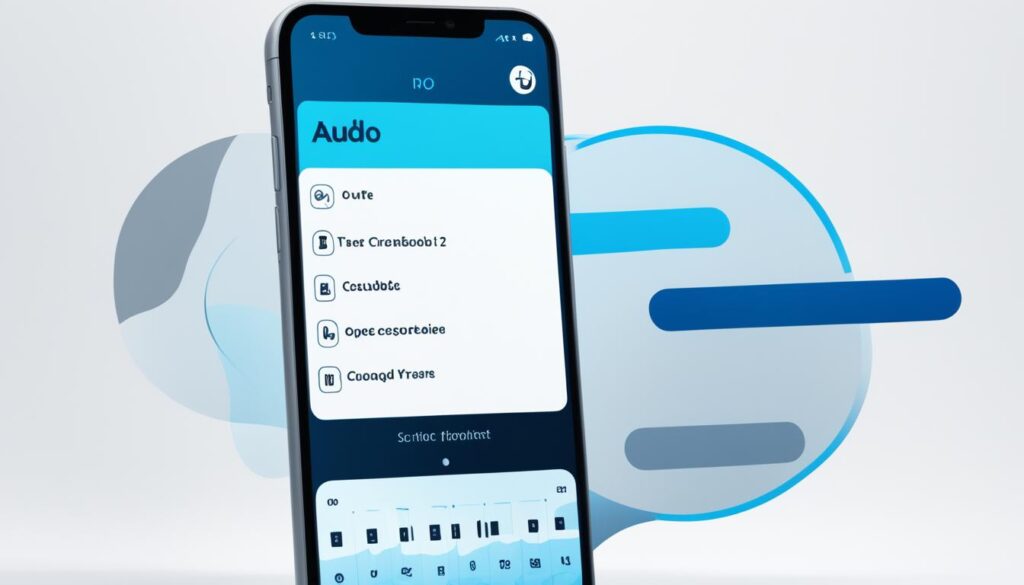
Skype Features for Hearing Impaired Users
Skype offers a range of accessibility features specifically designed to enhance communication for hearing impaired users. These features not only make it easier for individuals with hearing impairments to participate in audio and video calls but also ensure that they have the same level of accessibility as their hearing counterparts.
One key feature that Skype provides is the ability to toggle subtitles on and off during audio and video calls. This feature is especially beneficial for individuals with hearing impairments as it provides real-time transcriptions of the conversations, allowing them to read what is being said and actively participate in the discussion.
Additionally, Skype includes profile pictures of speakers next to transcribed text, making it easier for users to identify who is speaking. This visual aid enhances the overall communication experience and helps hearing impaired individuals follow the conversation more effectively.
Another valuable accessibility feature in Skype is the option to set a default language for subtitles. This allows users to customize their experience and receive transcriptions in their preferred language, further improving communication clarity and comprehension.
Skype also offers a transcription service that converts speech into instant text during calls. This service is extremely beneficial for deaf users, as it allows them to read the conversation in real-time instead of relying solely on audio cues. This transcription service greatly enhances accessibility for individuals who are deaf and ensures that they don’t miss out on important information shared during calls.
| Skype Features for Hearing Impaired Users | Description |
|---|---|
| Subtitles during calls | Toggle subtitles on and off to enable real-time transcriptions |
| Profile pictures of speakers | Visual aid to identify speakers and improve communication |
| Default language for subtitles | Customize the language for transcriptions |
| Transcription service | Converts speech into instant text for real-time reading |
These Skype accessibility features provide hearing impaired users with the necessary tools to effectively communicate and engage in conversations. By leveraging these features, Skype ensures inclusivity and equal accessibility for all users, regardless of their hearing abilities.

Other Communication Tools for Hearing Impaired Users
In addition to Skype, there are various communication tools and assistive technologies available for individuals with hearing impairments. These tools are designed to bridge the communication gap, improve accessibility, and enhance the overall communication experience for people with hearing loss. Here are some of the key communication tools:
Hearing Aid-Compatible Devices
Many modern smartphones and devices are compatible with hearing aids, allowing users to connect wirelessly and stream audio directly to their hearing devices. This feature enables hearing impaired individuals to have a clearer and more personalized audio experience during phone calls, video chats, and media playback.
Assistive Technology
Assistive technology offers a range of solutions to help individuals with hearing impairments communicate effectively. These technologies include captioning systems, visual signalers, and vibrating alert systems. Captioning systems provide real-time captions for spoken conversations, making it easier for hearing impaired individuals to follow along. Visual signalers and vibrating alert systems notify users of incoming calls, messages, or alarms through visual or tactile cues.
Speech Recognition Technology
Speech recognition technology has proven to be a valuable tool for the deaf community. It converts spoken words into text, allowing deaf individuals to read and understand conversations in real-time. This technology is widely used in speech-to-text apps and services, offering an accessible and convenient way for hearing impaired users to communicate and participate in conversations.
Real-Time Transcription Services
Real-time transcription services provide instant text conversion during voice and video calls, enabling hearing impaired users to read the conversation as it happens. These services utilize advanced speech recognition algorithms to provide accurate transcriptions, ensuring that no important information is missed. Real-time transcription services are particularly beneficial for individuals who rely heavily on written communication.
These communication tools and assistive technologies play a crucial role in empowering individuals with hearing impairments, allowing them to communicate more effectively and participate fully in various social and professional settings.

| Communication Tool | Description |
|---|---|
| Hearing Aid-Compatible Devices | Smartphones and devices that can connect wirelessly to hearing aids, providing improved audio quality and personalized sound. |
| Assistive Technology | Includes captioning systems, visual signalers, and vibrating alert systems, offering visual and tactile cues for communication. |
| Speech Recognition Technology | Speech-to-text apps and services that convert spoken words into written text, enabling deaf individuals to read and understand conversations. |
| Real-Time Transcription Services | Services that provide instant text conversion during voice and video calls, allowing users to read the conversation in real-time. |
Google Live Transcribe for Real-Time Transcription
When it comes to real-time transcription during conversations, Google Live Transcribe is a powerful speech-to-text app that stands out. With its advanced technology, this app accurately converts spoken words into text, making communication more accessible for individuals with hearing impairments. Furthermore, Google Live Transcribe supports multiple languages, ensuring a wide range of users can benefit from its functionality.
One of the notable features of Google Live Transcribe is its adjustable text size. Users can customize the appearance of the transcribed text to suit their visual preferences, enhancing ease of reading. Additionally, the app allows users to teach uncommon words to improve transcription accuracy.
For added convenience, Google Live Transcribe offers the option to set the phone to vibrate when someone says the user’s name. This feature ensures that users are alerted when their attention is needed, providing a seamless communication experience.
Google Live Transcribe: Accurate real-time transcription for seamless communication. #accessibility
With its comprehensive features and user-friendly interface, Google Live Transcribe is an excellent speech-to-text converter that promotes inclusivity in daily conversations. Whether it’s in professional settings or personal interactions, this app empowers individuals with hearing impairments to fully participate and engage with others.

Skype Translator for Instant Text Conversion
Skype Translator is a powerful feature of Skype that utilizes speech recognition technology to provide instant text conversion during voice and video calls. This feature is particularly valuable for hearing impaired users who rely on reading instead of listening to communicate effectively.
With Skype Translator, smooth and inclusive communication is made possible between individuals with different hearing capabilities. As spoken words are translated into instant text, hearing impaired users can easily read and understand the conversation in real-time.
This innovative speech to text technology for Skype ensures that no important information gets missed. It eliminates the barriers caused by hearing impairments and promotes clear, accessible communication for all users.
“Skype Translator enables smooth and inclusive communication for hearing impaired individuals by providing instant text translation of spoken words.”
Live Captioning and Clear Communication
One of the key features of Skype Translator is live captioning. As participants speak during a call, their words are instantly transcribed into text and displayed on the screen. This live captioning not only benefits hearing impaired users but also proves useful in various scenarios, such as when there is background noise or when participants speak different languages.
Live captioning ensures that every word is captured and conveyed accurately. It allows all participants to follow the conversation effortlessly and contribute effectively, regardless of their hearing abilities.
Enhanced Accessibility with Speech Recognition Technology
Skype Translator’s speech recognition technology is at the heart of its instant text conversion capability. This advanced technology accurately converts spoken words into written text in real-time, ensuring reliable and seamless communication.
With the help of speech recognition technology and live captioning, users can experience greater accessibility and inclusivity. The ability to read the conversation as it happens enables hearing impaired individuals to actively engage in discussions, share their thoughts, and stay connected with others.
A Visually Appealing and Relevant Image:

| Benefits of Skype Translator for Hearing Impaired Users: |
|---|
| 1. Instant conversion of speech into written text |
| 2. Real-time live captioning for clear communication |
| 3. Reliable and accurate speech recognition technology |
| 4. Enhanced accessibility and inclusive communication |
| 5. Seamless participation in voice and video calls |
TextHear for Speech-to-Text Transcription
TextHear is an innovative speech-to-text notepad app designed to meet the transcription needs of hearing impaired users. With real-time transcription capabilities, this app provides a convenient solution for converting spoken conversations into text format. Its user-friendly interface and customizable features make it an excellent choice for individuals seeking reliable speech-to-text transcription.
Key Features of TextHear:
- Automatic punctuation: TextHear automatically adds punctuation marks to the transcriptions, ensuring accuracy and readability.
- Adjustable font and size: Users can customize the text appearance to suit their preference, making it easier to read and comprehend.
- Save and share transcriptions: TextHear allows users to save transcriptions for future reference and share them with others, facilitating seamless communication.
TextHear can serve as a valuable alternative for hearing impaired individuals who require speech-to-text transcription. Whether it’s for academic purposes, work meetings, or personal conversations, this app empowers users by providing a reliable and efficient way to capture spoken words in real-time.
Using TextHear, hearing impaired individuals can actively participate in conversations without missing any crucial information. Its transcription capabilities improve accessibility and ensure effective communication.
Sample Transcription Comparison
Let’s compare a sample conversation before and after using TextHear:
| Original Conversation | Transcription with TextHear |
|---|---|
| “Hi, how are you doing?” | “Hi, how are you doing?” |
| “I’m great, thanks! What about you?” | “I’m great, thanks! What about you?” |
| “I went to the park and played soccer.” | “I went to the park and played soccer.” |
| “That sounds like a lot of fun!” | “That sounds like a lot of fun!” |
As seen in the comparison, TextHear accurately transcribes spoken words, ensuring that the essence of the conversation is captured effectively. With its easy-to-use interface and powerful transcription capabilities, TextHear is a valuable tool for hearing impaired users seeking seamless communication.
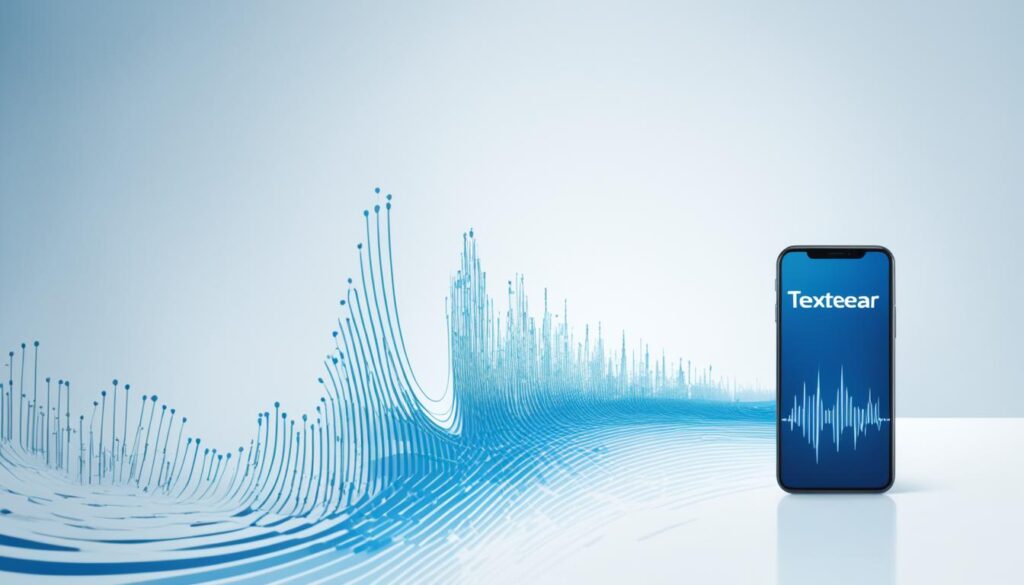
Hearing Helper for Live Transcription
When it comes to assistive technology for individuals with hearing loss, Hearing Helper is a game-changer. This innovative app provides real-time speech-to-text translation, bringing live transcription to one-on-one conversations or speech transcriptions for note-taking purposes.
One of the standout features of Hearing Helper is its customizable text size, allowing users to adjust the display to their specific needs. This ensures optimal readability, making it easier for individuals with hearing loss to follow along and engage in meaningful conversations. Additionally, the app offers the convenience of tapping and quick-editing words, providing a seamless user experience.
Although Hearing Helper is an excellent tool for real-time transcription, it does not have the feature to save transcripts for future reference. However, its live transcription capabilities make it a powerful asset for individuals with hearing loss in various situations, including meetings, classes, or social interactions.

Benefits of Hearing Helper:
- Real-time transcription for one-on-one conversations
- Speech transcriptions for note-taking
- Customizable text size for improved readability
- Tap and quick-edit words for a seamless user experience
With its intuitive design and live transcription capabilities, Hearing Helper empowers individuals with hearing loss to stay connected, informed, and engaged in their daily interactions. While it may not offer transcript-saving functionality, its real-time speech-to-text translation provides invaluable support for effective communication.
Deaf Communication Solutions with Relay Services
When it comes to facilitating communication for individuals with hearing impairments, relay services are an invaluable resource. Among these services, the Relay UK app stands out as a powerful tool in enabling effective communication. By providing a live relay assistant, the app bridges the gap between spoken language and text or sign language.
With the Relay UK app, deaf individuals can confidently engage in phone conversations or video calls, knowing that their messages will be accurately conveyed. The dedicated relay assistant translates spoken language into text or sign language in real-time, ensuring seamless communication and fostering inclusiveness.
Whether it’s a professional call or a personal conversation with a loved one, the Relay UK app delivers a reliable and efficient communication solution to the hearing impaired community. Through this innovative service, individuals with hearing impairments can express themselves effectively, share their thoughts, and actively participate in conversations.
To illustrate the significance of relay services, consider the following quote from a satisfied user of the Relay UK app:
“The Relay UK app has revolutionized the way I communicate. It has given me the freedom to express myself without any barriers. With the assistance of live relay service, I can comprehend spoken language effortlessly, enabling effective communication with people from all walks of life.”
By leveraging the power of relay services like the Relay UK app, the hearing impaired community gains the ability to communicate with ease, independence, and confidence.
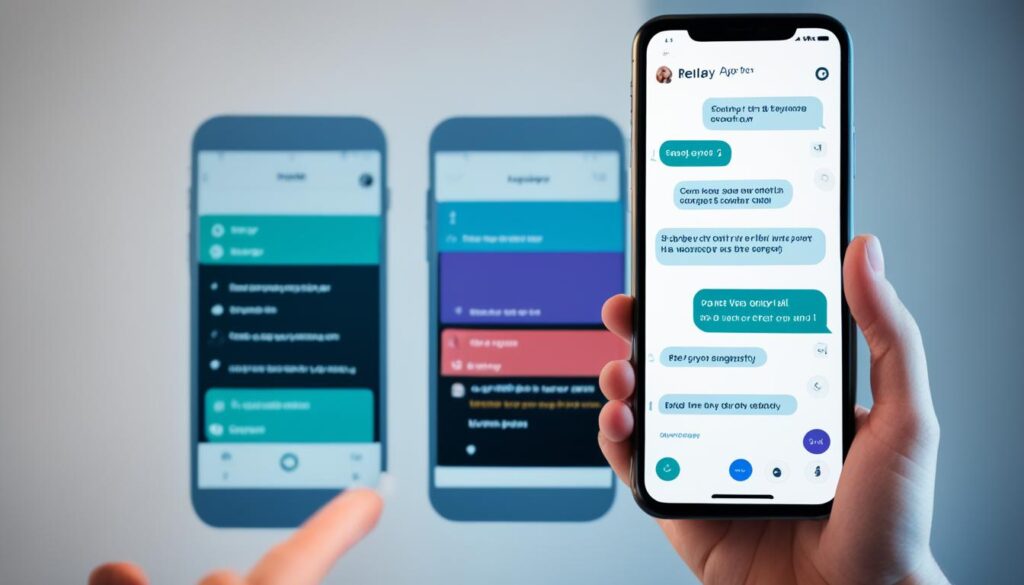
Skype and FaceTime for Sign Language Communication
In addition to the speech-to-text features discussed earlier, both Skype and Apple’s FaceTime app offer valuable communication options for the deaf community through sign language. By utilizing video calls, deaf individuals can engage in animated conversations using sign language, effectively expressing their thoughts and emotions.
Skype Translator, an innovative feature within Skype, takes this communication one step further. It provides instant text conversion of spoken language during voice and video calls. This real-time transcription enables better understanding and smoother communication between sign language users and their hearing counterparts.
| Communication Benefits | Skype | FaceTime |
|---|---|---|
| Animated Sign Language Conversations | ✓ | ✓ |
| Instant Text Conversion | ✓ | N/A |
| Real-time Transcription | ✓ | N/A |
| Accessibility Features | ✓ | N/A |
While both Skype and FaceTime contribute to sign language communication, it is important to note that Skype offers a more comprehensive range of features, including real-time transcription and accessibility enhancements.
With these tools at their disposal, the deaf community can unlock new possibilities for inclusive and effective communication, bridging the gap between hearing and non-hearing individuals.

Accessible Communication Solutions for Deaf and Hard of Hearing
For individuals who are deaf or hard of hearing, there are a variety of accessible communication solutions available. These tools and technologies help to improve communication and enhance accessibility, enabling individuals with hearing impairments to fully engage and participate in conversations.
One such solution is the use of text-to-speech apps. These apps convert written text into spoken words, allowing individuals with hearing impairments to easily understand and engage with written content. By using text-to-speech technology, individuals can have text documents, emails, or online articles read aloud to them, enabling them to stay connected and informed.
Another helpful tool is captioning services. These services provide real-time captions during live events or video conferences, making it easier for individuals with hearing impairments to follow along and participate. Captions display spoken words as text in real-time, enhancing comprehension and inclusivity in communication.
By utilizing text-to-speech apps and captioning services, individuals with hearing impairments can overcome communication barriers and participate fully in various social, educational, and professional settings.
In addition to digital solutions, there are also assistive devices that facilitate communication for the deaf and hard of hearing. One such device is a textphone, which allows individuals to communicate through text messages over the telephone network. This enables seamless communication with hearing individuals, eliminating the need for sign language interpretation.
Visual signalers are another useful assistive technology. These devices alert individuals with hearing impairments to various sounds, such as doorbells, smoke alarms, or telephone ringing, through visual cues, such as flashing lights or vibrating notifications. Visual signalers provide increased independence and safety for individuals by drawing their attention to important auditory cues.
It’s important to note that while these accessible communication solutions can greatly enhance accessibility and inclusivity for individuals with hearing impairments, it’s crucial to prioritize the preferences and needs of the individual. Communication tools and technologies should be chosen based on the individual’s specific requirements and comfort level.
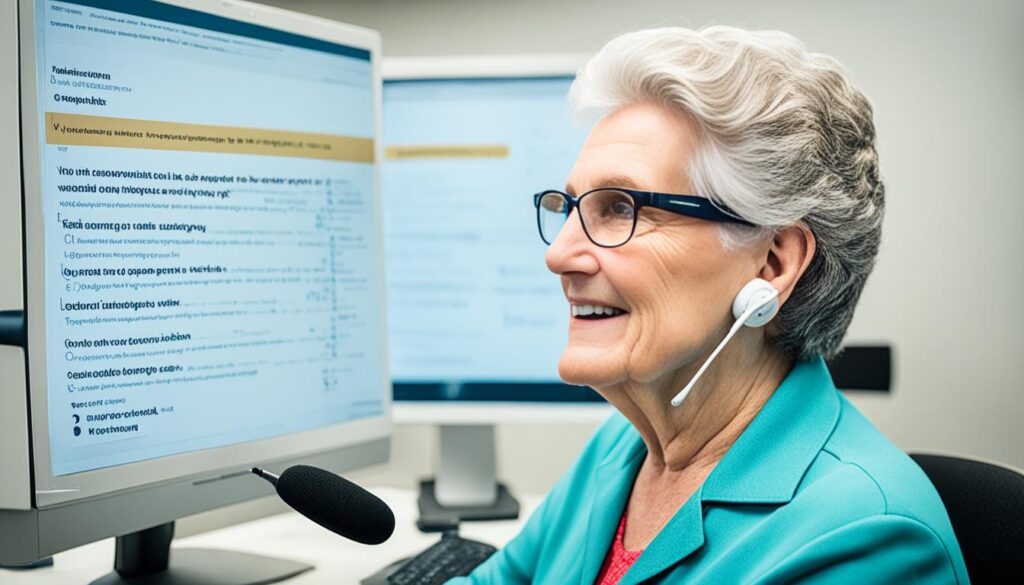
| Accessible Communication Solutions for Deaf and Hard of Hearing | Benefits |
|---|---|
| Text-to-speech apps |
|
| Captioning services |
|
| Textphones |
|
| Visual signalers |
|
Conclusion
Skype’s speech-to-text feature, along with other speech-to-text apps and communication tools, offers a significant improvement in communication for people with hearing impairments. These technologies provide real-time transcription and instant text conversion, enabling individuals to overcome communication barriers and engage more effectively in conversations.
By utilizing Skype’s speech-to-text feature and other accessibility tools, individuals with hearing impairments can benefit from the power of speech recognition technology. This technology enhances accessibility and inclusiveness in communication, making it easier for hearing impaired individuals to understand and participate in conversations.
Moreover, these tools are compatible with hearing aids, ensuring a seamless experience for users. By leveraging these accessibility tools, individuals with hearing impairments can feel more connected and engaged in both personal and professional settings.
In conclusion, the availability of speech-to-text features, speech recognition technology, and compatibility with hearing aids offers new possibilities for individuals with hearing impairments. These accessibility tools enhance communication and promote inclusivity, allowing everyone to participate fully in conversations and connect on a deeper level.
FAQ
What is Skype Speech to Text?
Skype Speech to Text is a feature that provides real-time transcription during voice and video calls, making it easier for people with hearing impairments to understand and participate in conversations.
How does Skype Speech to Text enhance communication for the hearing impaired?
Skype Speech to Text offers real-time transcription, allowing hearing impaired individuals to read the conversation in real-time. This feature enhances accessibility and inclusivity in communication.
What are some popular speech-to-text apps for smartphones?
Some popular speech-to-text apps for smartphones include Ava, Otter, Rogervoice, Google Live Transcribe, Google Live Caption, Speechnotes, and Hearing Helper. These apps provide various features to assist with speech-to-text transcription.
What features does Skype offer for hearing impaired users?
Skype offers the ability to toggle subtitles on and off during audio and video calls, profile pictures of speakers next to transcribed text, the option to set a default language for subtitles, and support for up to 24 participants on calls. Skype also provides a transcription service for instant text conversion.
What other communication tools are available for hearing impaired users?
In addition to Skype, there are other communication tools and assistive technologies available for hearing impaired users. These include hearing aid-compatible devices, speech recognition technology, and real-time transcription services.
What is Google Live Transcribe?
Google Live Transcribe is a speech-to-text app that provides real-time transcription during conversations. It accurately transcribes spoken words and offers adjustable text size, language support, and customizable settings.
How does Skype Translator enhance communication for hearing impaired users?
Skype Translator instantly converts speech into text during voice and video calls, allowing hearing impaired users to read instead of listen. It improves understanding between hearing and deaf individuals.
What is TextHear?
TextHear is a speech-to-text notepad app that enables real-time transcription of conversations. It offers features like automatic punctuation, adjustable font and size, and the ability to save and share transcriptions.
What is Hearing Helper?
Hearing Helper is a live speech-to-text translation app designed for people with hearing loss. It provides real-time transcription during conversations or for transcribing speech into notes. It offers customizable text size and quick-edit capabilities.
What are relay services?
Relay services, such as the Relay UK app, provide live relay assistants who translate spoken language into text or sign language. These services facilitate effective communication for individuals with hearing impairments over the phone or in video calls.
Can Skype and FaceTime be used for sign language communication?
Yes, both Skype and Apple’s FaceTime app can be used for sign language communication. Deaf individuals can engage in animated sign language conversations using video calls. Skype Translator further enhances this communication by converting spoken language into instant text.
What are some accessible communication solutions for the deaf and hard of hearing?
Accessible communication solutions for the deaf and hard of hearing include text-to-speech apps, captioning services, and assistive devices like textphones and visual signalers. These tools and technologies improve communication and accessibility for individuals with hearing impairments.
How do speech-to-text features improve communication for hearing impaired users?
Speech-to-text features like Skype Speech to Text provide real-time transcription, instant text conversion, and other helpful features to enhance accessibility and inclusiveness in communication for people with hearing impairments.

